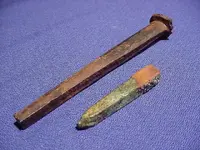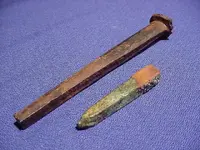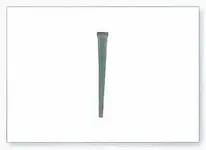coinmaster2db
Full Member
- Joined
- Jun 25, 2008
- Messages
- 235
- Reaction score
- 4
- Golden Thread
- 0
- Location
- Southern Indiana
- Detector(s) used
- White's DFX
I dig my share of old cut/square nails. They always look like this or worse.

But last fall, I dug this one.

I dug several others at that site, and they were rusted to pieces, so it's not due to ground conditions. It sticks to a magnet, so it's iron, or contains iron.
It sticks to a magnet, so it's iron, or contains iron.
Everybody digs cut nails (if they're on an old site). It gets annoying sometimes, but when I dug this one I told my buddy "I just dug the best cut nail I've ever seen". He laughed and continued to swing. I said "Seriously! Take a look at this thing".
I've only cleaned off the dirt. No electrolysis, AND YES...I DUG IT! I know it sounds silly, but I'm as proud of this find as I am some of the coins I've dug over the years.
Just had to share this one with y'all.
Happy Hunting!
Cm2db

But last fall, I dug this one.

I dug several others at that site, and they were rusted to pieces, so it's not due to ground conditions.
 It sticks to a magnet, so it's iron, or contains iron.
It sticks to a magnet, so it's iron, or contains iron. Everybody digs cut nails (if they're on an old site). It gets annoying sometimes, but when I dug this one I told my buddy "I just dug the best cut nail I've ever seen". He laughed and continued to swing. I said "Seriously! Take a look at this thing".
I've only cleaned off the dirt. No electrolysis, AND YES...I DUG IT! I know it sounds silly, but I'm as proud of this find as I am some of the coins I've dug over the years.
Just had to share this one with y'all.
Happy Hunting!
Cm2db





 . No, these early nails can be amazing!! I dug some pure smelted bog iron down here a few months ago and it was rust free, not a speck of rust! It's all about purity of the metal. Nice nail!
. No, these early nails can be amazing!! I dug some pure smelted bog iron down here a few months ago and it was rust free, not a speck of rust! It's all about purity of the metal. Nice nail!

 I'm certain that this nail dates back to at least the 1850's or 60's. The site is in the woods (now), and it's far enough away from everyone, that there isn't much traffic (just me and some hunters).
I'm certain that this nail dates back to at least the 1850's or 60's. The site is in the woods (now), and it's far enough away from everyone, that there isn't much traffic (just me and some hunters). 

